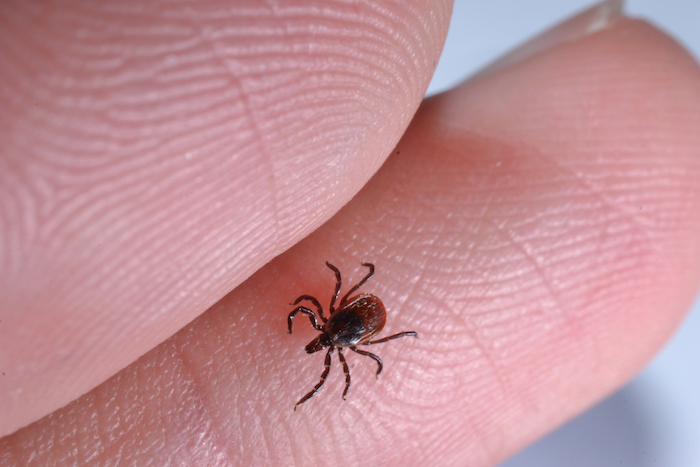Lyme disease is a tick-borne illness caused by infection with the bacteria Borrelia burgdorferi.
Who can get Lyme disease?
People of any age can get Lyme disease, particularly those who spend a significant amount of time in outdoor activities. It occurs most commonly during the late spring and early summer months, but can occur during the fall and winter. Dogs, cats and horses also can get Lyme disease.
Continue reading
Pets are important members of many families and the season’s summer showers and warm temperatures are bringing an unwelcomed risk to their health in the form of tiny, biting, blood-feeding pests. PermaTreat encourages people to protect their pets from ticks and fleas and safeguard against infestations.
Animals are ideal hosts for fleas and ticks because they are low to the ground and easy to hitch rides on, and their fur provides the perfect cover. These pests should be taken seriously as they pose significant health threats to both humans and animal friends, and are capable of transmitting multiple diseases.

Fleas, for instance, are an itchy annoyance causing flea allergy dermatitis, but they can also cause anemia, transfer tapeworms to animals and Bubonic Plague to humans. Ticks are equally dangerous, and depending on the species, are known to transmit Lyme disease, anaplasmosis, Babesiosis, Rocky Mountain spotted fever, and can even cause tick paralysis.
The best way to protect your family from biting pests is to prevent an infestation from occurring in the first place. Pet owners should employ the use of preventive treatment options, thoroughly check pets’ fur after every trip outside, and maintain outdoor properties to be less inviting to flea and tick populations.
PermaTreat provides additional advice for keeping fleas and ticks off your pets and out of your home:
- Avoid walking pets in tall grass and wooded areas.
- Wash pet bedding and plush toys.
- Vacuum frequently.
- Talk to your veterinarian about prevention/treatment options to repel or kill fleas and ticks, and learn more about heartworm protection.
- If you find a tick, remove it immediately by extracting the head and mouthparts completely. If fleas are found, bathe animals. Consult with a veterinarian.
- If pests are present in the home, contact a licensed pest professional.
For more information, visit: PermaTreat.com.
It’s summertime, which means more sunshine and more time outdoors playing, hiking and exploring nature. Unfortunately, this can also mean more quality time with some of nature’s most nefarious pests. Ticks, which are commonly encountered in tall grass and wooded areas, are one such notorious pest.

Although small in size, ticks can cause big problems by spreading dangerous diseases like Lyme disease and Rocky Mountain spotted fever. So, before heading outdoors this summer, check out the following little-known facts about ticks to learn more about these biting buggers.
-
Ticks are not insects.
It’s true. Ticks are not insects, although they are often mistaken for them. Ticks are actually classified as arachnids, or relatives of spiders, scorpions and mites. If you look closely at a tick when identifying it, it kind of resembles a spider with its four pairs of legs and lack of antennae.
-
Ticks are mini, real-life vampires… They want to suck your blood.
Did you know that ticks require a blood meal to survive. Blacklegged ticks, for example, primarily feed on the blood of white-tailed deer, but they will also bite mice, small wild animals, birds and humans.
-
Ticks are daredevils.
Ticks don’t jump or fly. Instead, they crawl up low brush or grass to find a host. Then, they clasp on with their back legs and reach their front legs out to grab onto a passing animal or human. This process is called questing. Sometimes, they even drop from their perch and free fall onto a passing host. Talk about a risky move!
-
Ticks are dog lovers, too.
Some ticks species, like the American dog tick and brown dog tick, prefer dogs as hosts. Unfortunately, dogs are often easy targets when playing in the yard or going for a walk in wooded areas. If you’re a pet owner, don’t forget to check FIDO frequently for ticks, especially after walks or playtime, and regularly wash bedding and plush toys.
-
When it comes to feeding, ticks are in it for the long haul.
Unlike many other biting pests, ticks are adapted to feed for long periods of time. They bury their curved teeth deeply into the skin of a host, so they can remain securely attached for days on end to eat. It’s important to note that ticks typically require 24-48 hours of feeding before they can successfully transmit infections like Lyme disease, so prompt removal is crucial.
Were you surprised by any of these tick facts? Ticks may pose a threat to our health, especially during the summer when people – and pets alike – spend increased amounts of time in the great outdoors. However, that doesn’t mean we all have to stay bunkered down on house arrest over the next few weeks. If you plan on taking advantage of the warm weather by hiking, biking, camping or going on an outdoor adventure this season, just make sure to follow these five tips to prevent tick bites.




































































